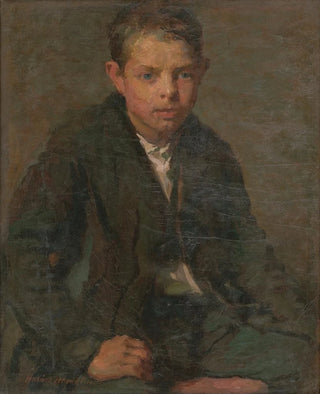Art print | Portrait of a young worker - Elemér Halász-Hradil


View from behind

Frame (optional)
Portrait of a Young Worker - Elemér Halász-Hradil – Captivating Introduction
In the vast panorama of art history, certain works stand out for their ability to capture the essence of an era and evoke deep emotions. The "Portrait of a Young Worker" by Elemér Halász-Hradil perfectly fits into this category. This piece, imbued with a unique sensitivity, immerses us in the struggles and aspirations of a rapidly changing working class. Through the gaze of the young man depicted, the artist invites us to reflect on the challenges and hopes of a generation, while offering a fascinating glimpse into daily life in the early 20th century. The art print of this work allows us to rediscover this historic moment while integrating it into our living space, adding a touch of authenticity and depth to our decor.
Style and uniqueness of the work
Elemér Halász-Hradil's style is characterized by poignant realism, where every detail is carefully crafted to convey an authentic atmosphere. In the "Portrait of a Young Worker," light plays a central role, illuminating the face of the protagonist and highlighting the features of his expression. The choice of colors, both earthy and vibrant, evokes the roughness of his environment while emphasizing the dignity of the individual. The young man's posture, slightly tilted, suggests both vulnerability and inner strength, illustrating the daily struggle of workers. Moving away from academic conventions, Halász-Hradil manages to create an emotional connection with the viewer, making the work timeless and universal.
The artist and his influence
Elemér Halász-Hradil, born in 1889 in Hungary, was an artist whose journey was marked by a quest for truth and social justice. Influenced by the realist movement, he skillfully integrated elements of expressionism to bring his characters to life. His commitment to representing the working and peasant classes is evident in many works, where he depicts the struggles of workers and farmers with remarkable empathy. Halász-Hradil was also a witness to the historical upheavals of his time, and his art reflects the social concerns of

Matte finish

View from behind

Frame (optional)
Portrait of a Young Worker - Elemér Halász-Hradil – Captivating Introduction
In the vast panorama of art history, certain works stand out for their ability to capture the essence of an era and evoke deep emotions. The "Portrait of a Young Worker" by Elemér Halász-Hradil perfectly fits into this category. This piece, imbued with a unique sensitivity, immerses us in the struggles and aspirations of a rapidly changing working class. Through the gaze of the young man depicted, the artist invites us to reflect on the challenges and hopes of a generation, while offering a fascinating glimpse into daily life in the early 20th century. The art print of this work allows us to rediscover this historic moment while integrating it into our living space, adding a touch of authenticity and depth to our decor.
Style and uniqueness of the work
Elemér Halász-Hradil's style is characterized by poignant realism, where every detail is carefully crafted to convey an authentic atmosphere. In the "Portrait of a Young Worker," light plays a central role, illuminating the face of the protagonist and highlighting the features of his expression. The choice of colors, both earthy and vibrant, evokes the roughness of his environment while emphasizing the dignity of the individual. The young man's posture, slightly tilted, suggests both vulnerability and inner strength, illustrating the daily struggle of workers. Moving away from academic conventions, Halász-Hradil manages to create an emotional connection with the viewer, making the work timeless and universal.
The artist and his influence
Elemér Halász-Hradil, born in 1889 in Hungary, was an artist whose journey was marked by a quest for truth and social justice. Influenced by the realist movement, he skillfully integrated elements of expressionism to bring his characters to life. His commitment to representing the working and peasant classes is evident in many works, where he depicts the struggles of workers and farmers with remarkable empathy. Halász-Hradil was also a witness to the historical upheavals of his time, and his art reflects the social concerns of






